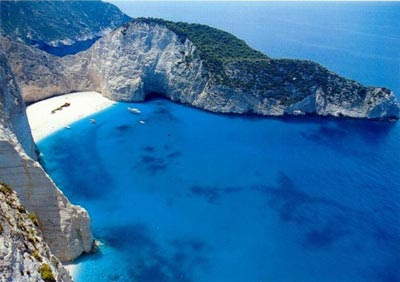Sandy international career Lalaria located in Skiathos and the natural setting has taken part in Hollywood productions such as Mamma Mia.

.Emerges among the rocks, creating a small channel for lovers, or otherwise the famous beach of Canal d 'Amour, on the north side of Corfu.

The Kavourotripes situated at Halkidiki Peninsula and small beaches with ... τροπικά νερά! tropical waters!

The Wreck of the island is the star of the Ionian Islands and is posing in Greek and international covers of guidebooks.

As if you walk on another planet, not earth Sarakiniko. Beach on the north side of the island facing the island of Sifnos and Kimolos.

Beach postcard registered trademark of Kefalonia, with constant Myrtou award-winning beach.

Επόμενη στάση Μπάλος! Next stop Balos! Warm sea with crystal waters and stunning color in the sand. … It is considered the most impressive part of Chania with Elafonisi ...

... Is the famous island of Crete with white sand that will amaze with its exotic beauty!

Perfect semicircular shape and turquoise waters, just like the beaches of your dreams! Voidokilia is definitely one of the most beautiful beaches in West Messinia and the whole of Greece.

The Miss Mediterranean beach is the drink Kid Lefkada. Sand and blue water is a must in the Greek summer.

Certainly there are many more beaches that are worth mentioning as other than the view is breathtaking, at 387 beaches will fly this year and "Blue Flag". This means that Greece is still ranks second among 41 countries, with Spain this year to keep the lead with the best beaches in the world!
.Emerges among the rocks, creating a small channel for lovers, or otherwise the famous beach of Canal d 'Amour, on the north side of Corfu.
The Kavourotripes situated at Halkidiki Peninsula and small beaches with ... τροπικά νερά! tropical waters!
The Wreck of the island is the star of the Ionian Islands and is posing in Greek and international covers of guidebooks.
As if you walk on another planet, not earth Sarakiniko. Beach on the north side of the island facing the island of Sifnos and Kimolos.
Beach postcard registered trademark of Kefalonia, with constant Myrtou award-winning beach.
Επόμενη στάση Μπάλος! Next stop Balos! Warm sea with crystal waters and stunning color in the sand. … It is considered the most impressive part of Chania with Elafonisi ...
... Is the famous island of Crete with white sand that will amaze with its exotic beauty!
Perfect semicircular shape and turquoise waters, just like the beaches of your dreams! Voidokilia is definitely one of the most beautiful beaches in West Messinia and the whole of Greece.
The Miss Mediterranean beach is the drink Kid Lefkada. Sand and blue water is a must in the Greek summer.
Certainly there are many more beaches that are worth mentioning as other than the view is breathtaking, at 387 beaches will fly this year and "Blue Flag". This means that Greece is still ranks second among 41 countries, with Spain this year to keep the lead with the best beaches in the world!





























